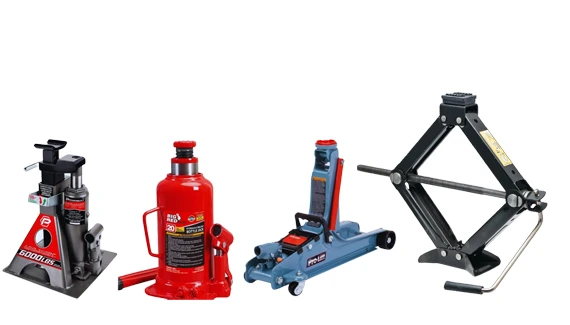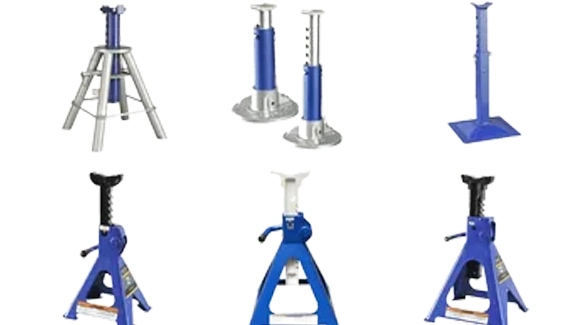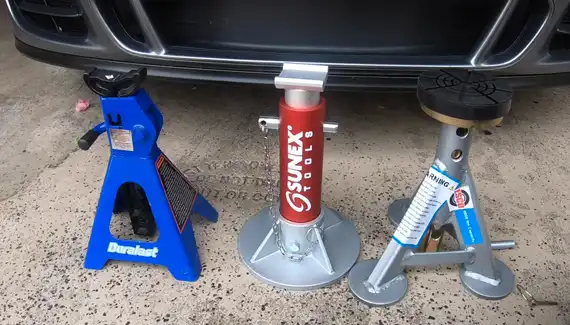Last Updated on April 17, 2023
To ensure a safe and smooth jacking-up experience in your RV, you must ensure that the jack stands to match its size perfectly. Otherwise, it could lead to potentially dangerous scenarios, so choose wisely.
Depending on your RV type, Class A, B, and C RVs all require different tonnages ranging from 3 – 12 tons.
Class A RVs usually need 10-12 ton stands, while Class B will require 3-6 tons. If it’s a hefty Class C model that needs support, 6-10 tons should do the trick.
Let’s find out how to accurately determine the perfect jack stand size for your RV. We’ll take a look at weight, measurements, and more, so you can get exactly what you need.
How to Determine the Exact Size Jack Stands You Need for Your RV?

Stability and safety are paramount regarding RV or travel trailer maintenance and repair. To guarantee you have the right size jack stands for your vehicle’s make and model, here’s what to do:
1. Determine the Weight of Your RV
To determine which type of jack stands are best for your RV, you need to find out how much your vehicle weighs. You can do this a few different ways.
The easiest step in determining your RV’s weight is to consult the owner’s manual or other documentation that came with it. This information should provide a general range of weights for each type of recreational vehicle.
For instance, Class A RVs typically range from 33,000-36,000 pounds. Class B RVs usually weigh between 6,000 and 11,000 lbs, and Class C RVs usually weigh around 12,000 to 20,000 lbs.
Once you have an idea of what your RV weighs, you can then begin selecting jack stands based on their size and weight rating.
Another method is to weigh your RV on a commercial truck scale. Truck scales are usually found at weigh stations and will give you an accurate reading of the total weight of your vehicle and its passengers, including any cargo that you may have inside or attached to the exterior.
You can also use something called an axle scale to measure each individual axle’s weight by driving over it slowly and checking the readings.
The advantage of this method is that it can tell you if one side is heavier than the other, which could indicate an uneven load or a problem with one wheel bearing or tire.
2. Determine the Tire Size of Your RV
Once you have determined your RV’s total weight, you will need to know what size tires it has to select RV camper jack stands with compatible bases and fittings. There are several ways to determine what size tires are on your vehicle.
One option is to look at the sidewalls of each tire for markings such as “P225/75R16,” which indicates that they are P-metric tires with a 225-millimeter width (the first number), a 75 aspect ratio (the second number), and 16-inch rims (the third number).
Another way is to check the manual for information on recommended tire sizes or contact your RV manufacturer directly for more details about what size tires came standard on your model of the rig.
You can also look up specifications online if these sources don’t give you enough info about what size tires were originally on your vehicle.
3. Check the Weight Capacity of the Jack Stands
When selecting jack stands for an RV, it is important to take into consideration the weight capacity and stability of each stand before purchasing or using them for support.
To determine how much weight each hydraulic jack stand can handle, look at its maximum rated load capacity, which is indicated in pounds (lbs).
Remember that jack stands have different maximum capacities, which vary depending on their design and construction material. Be sure to pick a model that can safely hold up your entire rig without buckling or bending under its own weight!
4. Check the Base Plate on the Jack Stand
When checking out the potential jack stands for an RV, make sure to examine their base plates closely.
These should be equal in size to or slightly larger than those found on either side of your vehicle’s frame where you intend to use them for support purposes.
When mounted to their respective locations, these plates provide maximum strength and stability. You’ll also avoid excessive strain or pressure elsewhere on your rig’s structure due to misaligned placement or incorrect fitment.
By following these steps and carefully selecting the appropriate size trailer jack stands for your RV, you can ensure a safe and stable environment when performing maintenance or repairs on your RV.
How Many Jack Stands Do I Need for an RV?

When it comes to determining how many jack stands you need for an RV, it all depends on what you’re using them for.
If you’re just parking and leveling your RV, then two jack stands per axle or four total is recommended. But if you’re doing maintenance or repairs, such as changing a flat tire, then one or two jack stands should suffice.
It’s important to use at least two jack stands anytime you work on your RV, one on either side of the vehicle. This will provide a much more stable base so the RV won’t tip over while you’re working on it.
You also need to consider the RV’s weight and size when choosing jack stands. For example, if your RV is especially large or heavy, then it’s best to use more than four jack stands for added stability.
This will help ensure that your RV stays in place during repair work and prevent any potential accidents from occurring.
Also, make sure that the jack stands are rated for the amount of weight they’ll be holding up and that they are securely fastened in place before getting started with any work.
Can I Use Car Jack Stands for an RV?
Using car jack stands on an RV is generally not recommended due to their inadequate design to support the weight and size of an RV.
Car jack stands typically have a much lower weight capacity than what an RV needs, usually starting at 2 tons, while RVs require at least 3 ton jack, depending on their weight.
RVs are much larger and heavier than cars, so they require jack stands with a higher weight capacity to provide proper support and stability. If car jack stands are used for an RV, it could result in the stands collapsing due to the extra weight, causing serious damage or potential injury or death.
Car jack stands may not provide enough stability to handle the weight of an RV, which could cause it to shift off the stands while they are being used.
When considering whether or not to use car stands on your RV, you should always make sure that they can support the weight of your RV first.
Be aware of any safety risks that could arise when using them for your vehicle. If there is any doubt about their ability to hold up your RV safely, it would be wise to avoid using them altogether and instead opt for heavier-duty jacks designed specifically for RVs.
If you plan to use car jack stands to raise your RV, be sure to follow all necessary precautions and proper safety protocols to minimize the possibility of any injury or damage to your RV or fifth wheel.
Ensure the stands are placed on level ground and securely attached before lifting or supporting any vehicle or item.
It is also essential to use appropriate safety gear, such as protective gloves, when handling heavy items or tools, and never attempt to lift anything beyond your own capabilities.
How Long Can I Leave an RV Supported By Jack Stands?

The length of time an RV can be left supported by jack stands will depend on several factors, including the weight of the RV, the capacity of the jack stands, and the surface on which the RV is parked.
Generally, it is recommended not to leave an RV on jack stands for an extended period, such as several weeks or months. RV jack stands are designed for temporary use during maintenance or repairs and are not intended to support the weight of an RV for extended periods.
If you need to leave your RV supported by jack stands for a short period, such as a few days, check the stands regularly to ensure that they remain stable and secure. It is also important to park the RV on a level surface and to distribute the weight evenly to prevent the stands from tipping or collapsing.
Suppose you need to store your RV for a longer time. In that case, it is recommended to use alternative support methods, such as using an RV stabilizer jack or leveling blocks or a dedicated RV storage facility with proper support.
Make Safety a Priority – Select the Right Jack Stand Based on Your RV’s Weight and Type
Choosing the right size jack stand for your RV can make a huge difference in terms of safety and stability while driving or parked.
Considering the weight and size of your RV, and its class type can help you determine which type of RV jack stand best suits your needs.
The size of your RV’s jack stand is determined by weight and type. Most RVs can be safely supported with stands between 3-12 tons, ensuring a safe setup every time.
You’ll need 10-12 tons for Class A RVs, 3-6 tons for Class B RVs, and 6-10 tons for Class C RVs. Be sure to invest in quality equipment that will get the job done and keep you safe.
